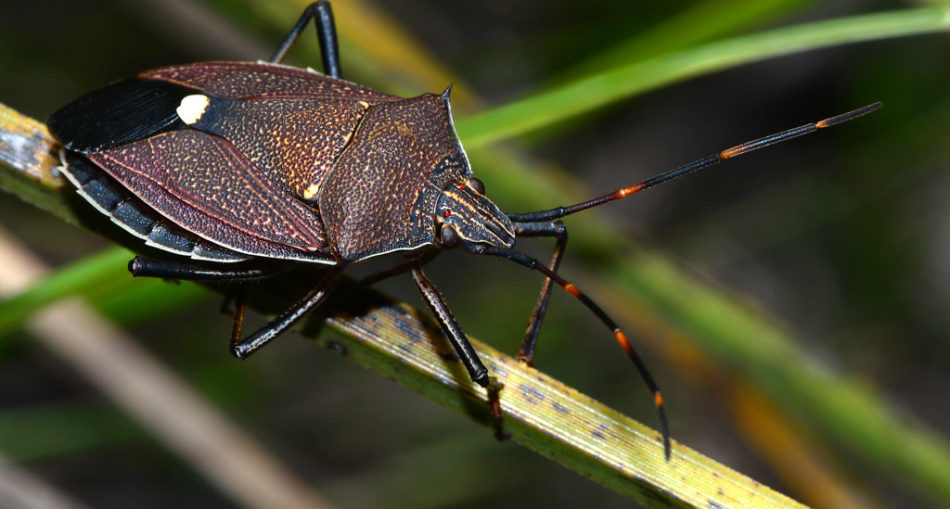My first encounter with this bug was not a very pleasant experience. I was out in the garden and saw one crawling on a hibiscus leaf, not knowing what it was I picked the entire leaf to go show my mother. “Don’t touch it,” she warned but as a very inquisitive child I could not help myself, I touched it. The bug excreted a liquid substance on my hand and it smelled awful. I washed my hands several times and ever since, whenever I see one I try to avoid it as best as I could. This bug that attacked me with its foul stench is called the ‘Stink bug’.
Stink bugs are native to East Asia in countries such as China, Japan, and Korea.
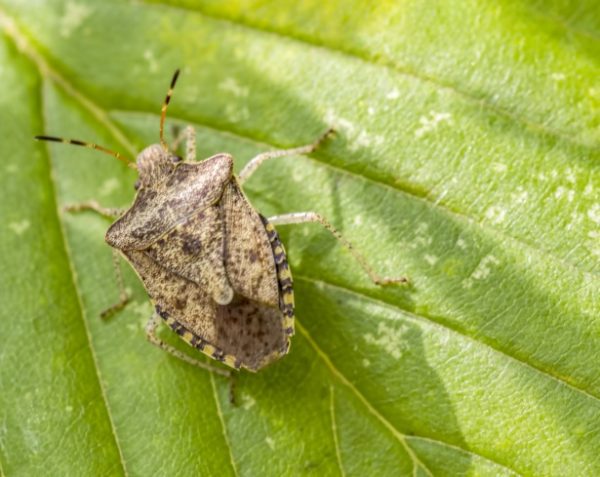
Photo of Stink Bug. Photo Source: https://www.publicdomainpictures.net/en/view-image.php?image=227707&picture=brown-marmorated-stink-bug
Scientific Classification
Kingdom: Animalia
Phylum: Arthropoda
Class: Insecta
Order: Hemiptera
Suborder: Heteroptera
Family: Pentamoidae
Genus: Halomorphia
Description
The heraldic shield-shaped adult brown marmorated stink bugs measure around 1.7 cm (0.67 in) in length and width. When viewed from above, they are often dark brown with a creamy white-brown underside. Some bugs can have a wide range of red, grey, light brown, copper, or black hues as their primary color.
Habitat
Stink bugs live in orchards, gardens, and farms.
Diet
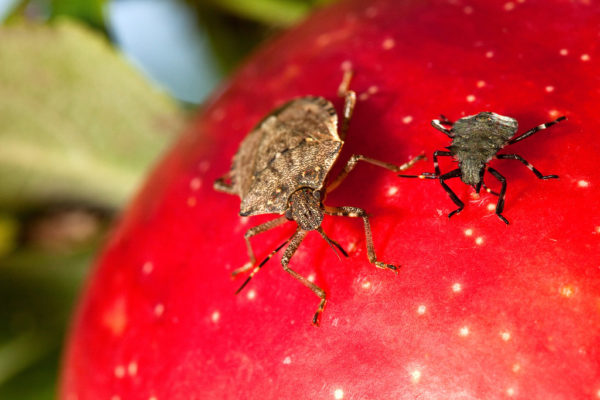
Stink Bug Feeding. Photo Source: https://www.flickr.com/photos/usdagov/8411876337
Stink Bugs eat leaves, flowers, fruit, and crops such as soybeans. The brown marmorated stink bug is a sucking insect that feeds by piercing the host plant with its proboscis (an elongated, tubular structure that is used for sucking food into the body). Part of the effects of this feeding includes the development of dimpled patches on the fruit’s outer surface, leaf stippling, seed loss, and perhaps the spread of plant infections. It is an agricultural pest that has the potential to seriously harm the harvests of fruits and vegetables.
Reproduction
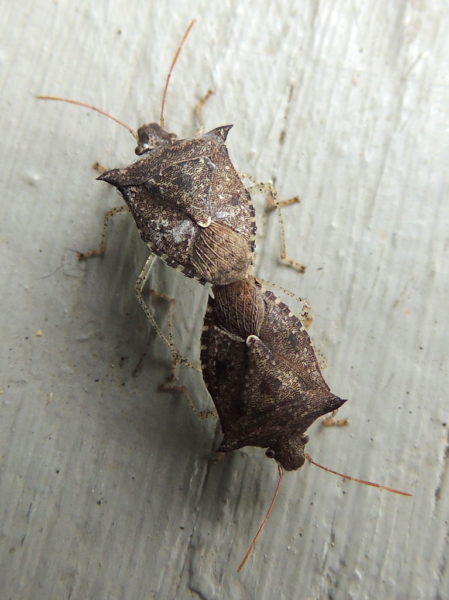
Stink Bugs Mating. Photo Source: https://www.flickr.com/photos/anitagould/14795773891
As with all stink bugs, during courtship, the male sends out pheromones and vibrational signals to connect with the female, who responds with her own vibrational signals. The signals are used by the insects to identify and find one another. Egg laying generally occurs from May through August.
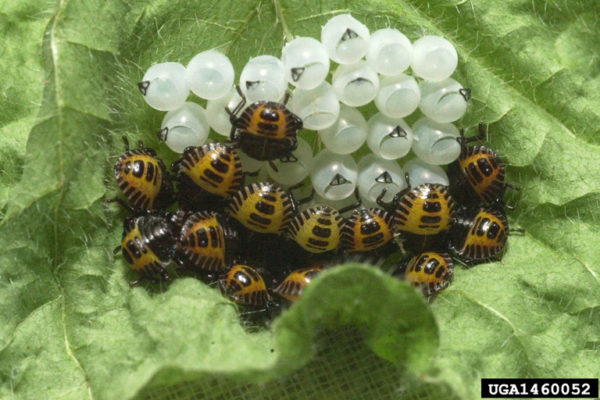
Stink bug eggs. Photo Source: https://entnemdept.ufl.edu/creatures
The eggs are light green, barrel-shaped, and are attached side-by-side on the underside of the host plant’s leaves in a mass of 20-30 eggs. After 4 to 5 days, nymphs, the second stage of the stink bug life cycle, hatch from their eggs.
They are orange or crimson in color, and until they molt, they stay grouped around the egg mass (shed their outer shell). Their sizes range from 2.4 to 12 millimeters. Nymphs have been compared to ticks because they lack fully formed wings, like all immature stink bugs.
The nymphs turn nearly black during the second instar and subsequently take on more of the adult colouration. About a week passes between each nymphal instar, and adults can start reproducing as soon as two weeks after their final molt.
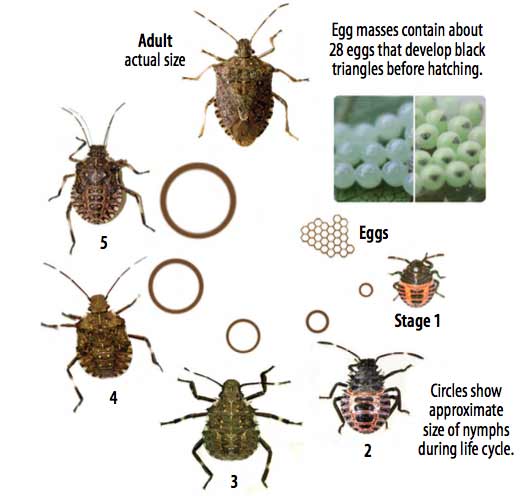
Lifecycle of Stink Bug. Photo Source: http://wewarriors.life/Stink-Bug-Life-Cycle-fd57.html
Why Do Stink Bugs Stink?
The defense mechanism used by stink bugs to produce an odor through holes in their abdomens is intended to keep birds and reptiles from eating them. However, the insect may emit the smell just from handling it, injury, or an attempt to relocate it.
Damages Caused
The brown marmorated stink bug is a serious agricultural pest that has been readily causing damage to crops.
When the grains are attacked during the milky stage, their contents are sucked out resulting in empty glumes or wind paddy. When attacked during the dough stage they become discolored. Consequently, there are reduced yields, quality, and black grains in parboiled rice. It also increases breakage on milling.
How To Control Stink Bugs
1. Cover all access points
Spend some time looking for easy access spots on the exterior of your property in order to properly control stink bugs. Keep a close eye on places like the spaces behind the siding and utility pipes, spaces between wood, or other openings.
2. Turn off your lights
Stink bugs are attracted to lights, so it’s recommended to keep outdoor lighting to a minimum. During the evenings, turn off porch lights and pull down window blinds to prevent light from spilling outside.
3. Reduce moisture sites.
Eliminating all moisture build-up around your home can go a long way to help prevent many pest infestations. Check for leaking pipes and clogged drains.
4. Get rid of food sources
Removing the stink bugs’ access to food is another way to get rid of them. Keep food in airtight containers and frequently dispose of trash in closed containers. To get rid of spilled crumbs and residue, be careful to sweep floors and wipe down counters.
References:
- https://www.pestworld.org/news-hub/pest-articles/stink-bug-control-10-tips-to-keep-this-smelly-pest-at-bay/
- https://en.wikipedia.org/wiki/Brown_marmorated_stink_bug
- https://www.orkin.com/pests/stink-bugs/stink-bug-life-cycle
- https://www.pestworldforkids.org/pest-guide/stink-bugs/#:~:text=Habitat%3A,in%20orchards%2C%20gardens%20and%20farms.
Discover more from Things Guyana
Subscribe to get the latest posts sent to your email.

